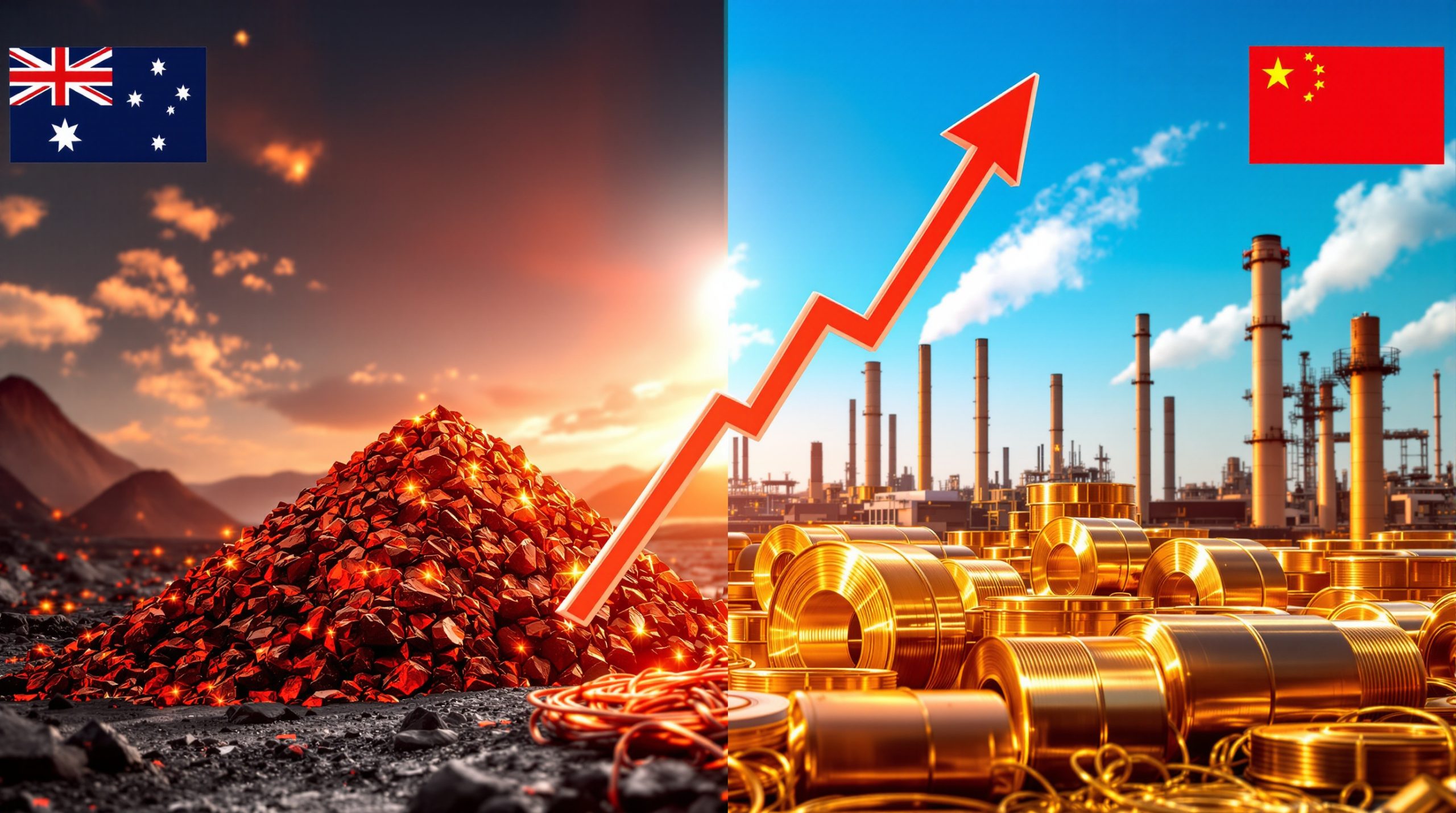Goldman Sachs Raises Copper Price Forecast: What This Means for the Market
Goldman Sachs has significantly revised its copper price forecast for 2025, signaling important shifts in the global metals market. The investment bank recently increased its Q2 2025 projection to $9,330 per tonne from the previous $8,620, representing an 8.2% upward adjustment. Similarly, the Q3 forecast saw a substantial boost to $9,150 per tonne from $8,370, reflecting growing confidence in copper's near-term strength.
The current London Metal Exchange (LME) benchmark price of $9,538 per tonne already exceeds these revised forecasts, suggesting strong market momentum. This price action comes amid complex global dynamics affecting one of the world's most critical industrial metals.
Financial analysts are closely monitoring these developments as copper serves as a key barometer for economic health, often earning its nickname as "Dr. Copper" for its ability to predict broader economic trends. For those interested in understanding the future trajectory, recent copper price insights from industry experts provide additional context.
What Factors Led to Goldman Sachs' Revised Copper Forecast?
Key Drivers Behind the Forecast Upgrade
The upward revision in Goldman Sachs' copper price forecast stems from several converging factors. Most notably, a significant de-escalation in global trade tensions has improved market sentiment, reducing uncertainty that previously weighed on prices. This diplomatic thawing has coincided with surprisingly resilient demand patterns from China, defying earlier predictions of a substantial slowdown.
Another critical factor is the accelerated depletion of ex-US copper stocks, with inventories dropping approximately 30% as American buyers aggressively secure supplies. This inventory drawdown is directly linked to elevated US imports, creating regional supply imbalances that support higher prices.
Technical market indicators also support Goldman's bullish outlook. The tightening of London Metal Exchange forward spreads – with the cash-to-three-month spread moving from a $20 per tonne contango in Q1 to a $50 per tonne backwardation – signals growing near-term supply constraints. This market structure creates unattractive conditions for speculators holding short positions, as the cost of rolling over contracts increases substantially.
The Numbers: From Previous to Current Forecasts
Goldman Sachs' forecast adjustments represent a substantial shift in market expectations:
- Q2 forecast: Increased to $9,330 per tonne (from $8,620 per tonne)
- Q3 forecast: Raised to $9,150 per tonne (from $8,370 per tonne)
- Current LME benchmark price: $9,538 per tonne (as of May 2025)
These revisions reflect a reassessment of underlying supply-demand dynamics and suggest copper may maintain strength even amid broader economic uncertainties. The relatively modest pullback projected for Q3 indicates Goldman's analysts anticipate sustained fundamental support throughout 2025. Understanding effective copper investment strategies can help investors navigate this changing landscape.
How Is China Influencing the Copper Market Outlook?
China's Demand Dynamics
As the world's largest copper consumer, accounting for approximately 55% of global demand, China's consumption patterns remain the single most influential factor in price formation. Currently, export-driven demand continues to support Chinese copper consumption, maintaining market firmness through the first half of 2025.
However, Goldman Sachs anticipates an 8% decline in Chinese demand during Q3 as recently implemented tariffs begin affecting trade flows. This projected slowdown represents a significant headwind that explains the bank's slightly lower Q3 price forecast compared to Q2.
More concerning is the potential for a supply crunch outside the US, particularly affecting Chinese manufacturers. With global shipments increasingly diverted to American buyers, Chinese fabricators face challenges securing adequate material. This situation has already manifested in surging Shanghai copper premiums, which reached $120 per tonne in April 2025 – a clear indicator of tightening physical availability.
Global Demand Trajectory
The broader global demand picture shows significant regional variations. While a substantial slowdown is predicted for the second half of 2025, this decline will not be uniform across markets:
- Electrification sectors (electric vehicles, renewable energy, grid infrastructure) continue providing sturdy underlying support, accounting for a projected 60% of demand growth through 2026
- Regional demand variations increasingly reflect industrial specialization, with areas focused on electronics and EV production maintaining relatively stronger consumption
- Seasonal factors, particularly construction activity in the Northern Hemisphere, will influence consumption patterns during the remainder of 2025
These divergent trends create a complex global demand landscape that traders must navigate carefully as they position for the anticipated supply deficit in 2026. Furthermore, analysts are noting rising copper demand across various sectors, particularly in electrification initiatives.
What Role Do Tariffs Play in Copper Market Volatility?
Current Tariff Situation
The copper market currently faces significant uncertainty regarding US import tariffs, with a pending decision that could impose duties of 10-15% on copper imports. Industry sources indicate potential delayed implementation until late 2025, creating an extended period of policy ambiguity.
This uncertainty has triggered substantial market disruption from trade flow alterations, as buyers and sellers attempt to anticipate and adapt to changing regulations. Global copper shipments are already being redirected, creating regional surpluses and deficits that wouldn't exist under normal trading conditions.
A notable consequence has been the emergence of regional price differentials, with US markets commanding a premium of approximately $200 per tonne compared to Asian markets. This price divergence reflects both actual supply constraints and speculative positioning ahead of potential tariff implementation. According to recent reports from Reuters, Goldman Sachs believes these tariffs may actually help prevent a copper glut in the US market.
Market Response to Tariff Uncertainty
The copper industry is responding to tariff uncertainty through several strategic adjustments:
- Preemptive inventory building in potentially affected regions, particularly by US manufacturers concerned about future supply access
- Price premium development in markets facing potential import restrictions, creating arbitrage opportunities for traders
- Supply chain restructuring to navigate the changing trade landscape, with smelters in Southeast Asia expanding capacity to bypass potential US tariffs
- Strategic positioning by major consumers and producers, with European fabricators increasing forward contracts to hedge against tariff-driven price volatility
These adaptive responses highlight the market's flexibility but also introduce additional complexity and transaction costs that ultimately impact end-users. Recent US copper investment insights demonstrate how American stakeholders are responding to these changing dynamics.
What Are Goldman Sachs' Long-Term Copper Projections?
Supply-Demand Balance Forecast
Goldman Sachs projects a fundamental shift in copper market dynamics over the coming years, with a transition from the current relative balance to a significant supply deficit by 2026. This structural change is driven by diverging trends in supply and demand.
On the demand side, the bank forecasts 3.5% annual growth through 2026, primarily driven by electrification sectors. This robust expansion contrasts sharply with supply forecasts showing mining output growth capped at just 1.2% annually due to declining ore grades at existing operations.
This widening gap is expected to create a 4.2 million tonne deficit by 2026, providing powerful price support. Goldman's analysts chart a price trajectory from $9,000 per tonne in October 2025 to over $10,500 per tonne by the end of 2026 – an increase that would mark multi-year highs for the industrial metal.
Structural Market Changes
The anticipated deficit reflects deeper structural changes in the copper market:
- Project development timelines pose a significant challenge, as new mines typically require 8-10 years to become operational, creating a substantial lag in supply response
- Investment implications for mining companies are substantial, with premium valuations likely for producers with expansion capacity and low-cost operations
- Critical supply constraints are increasingly evident, exemplified by Chile's Cobre Panamá mine closure in 2024, which removed 350,000 tonnes annually from global supply
- Energy transition acceleration continues to drive copper intensity in modern economies, with limited opportunities for material substitution
These structural factors suggest that even temporary price pullbacks should be viewed in the context of a longer-term bullish trajectory as the market transitions from relative balance to chronic undersupply. In fact, Goldman Sachs has raised its outlook for both copper and aluminum prices for 2025, reflecting these fundamental shifts.
How Should Investors Interpret These Copper Market Signals?
Investment Implications
The revised Goldman Sachs copper forecast presents several strategic considerations for investors. In the near term, price volatility – currently running at approximately 20% annualized for copper futures – creates tactical trading opportunities. However, Goldman Sachs advises a focus on long-term positioning for the anticipated supply deficit.
Investors should consider:
- Regional exposure optimization, with miners serving US markets currently commanding a 15% premium over peers with primarily Asian exposure
- Sector allocation strategies that target copper-intensive industries, particularly those linked to electrification and grid infrastructure
- Cost curve positioning as a key metric, with producers in the lowest quartile of the global cost curve best positioned to benefit from tight markets
- Derivatives strategies that allow participation in price appreciation while managing the substantial volatility inherent in commodity markets
The performance divergence is already visible, with major copper producers like Freeport-McMoRan seeing share price appreciation of 12% in Q2 2025 following the revised price forecasts.
Risk Factors to Monitor
Despite the constructive outlook, investors should maintain vigilance regarding several key risk factors:
- Trade policy developments, particularly the pending US tariff decision, could dramatically alter regional pricing and trade flows
- China's economic performance remains critical, with the potential for deeper-than-expected slowdowns if export markets weaken
- Mining project development timelines could accelerate if prices rise substantially, potentially bringing new supply online faster than anticipated
- Substitution risks from alternative materials pose a long-term threat, though current substitution rates remain modest at approximately 5% annually
Prudent investors will incorporate these risk factors into position sizing and hedging strategies while maintaining exposure to what increasingly appears to be a multi-year bullish cycle.
What Is the Current State of Global Copper Inventories?
Inventory Levels and Distribution
Global copper inventories have reached critically low levels in several key regions:
- LME warehouses currently hold approximately 150,000 tonnes, representing a 40% decline year-over-year
- Shanghai Futures Exchange inventories have dropped to 80,000 tonnes, their lowest level in five years
- Regional imbalances have created pronounced arbitrage opportunities, with material flowing to premium markets
- Strategic stockpiling by entities including Chinese state reserves has further tightened physical availability
These depleted inventory levels leave little buffer against supply disruptions or demand surprises, amplifying price sensitivity to market developments. The current inventory situation represents one of the tightest physical markets in recent years. Understanding the global supply forecast provides crucial context for these inventory trends.
Impact on Price Spreads
The inventory drawdown has directly influenced market structure, particularly in derivatives markets:
- Tightening LME forward spreads reflect immediate physical shortages rather than anticipated future scarcity
- Cash-to-three-month price relationships have shifted from contango to backwardation, increasing carrying costs
- Physical premium developments show significant regional variations, with European buyers currently paying a $100 per tonne premium for prompt delivery compared to Asian counterparts
- Strategic repositioning by major producers is evident, with companies like Codelco diverting substantial volumes (50,000 tonnes) from traditional routes to capitalize on regional premiums
These technical market indicators provide important validation of Goldman Sachs' fundamental analysis and suggest continued support for prices even before the anticipated structural deficit emerges.
FAQ: Copper Market Outlook
What is causing the current copper price volatility?
Market volatility stems from a complex interplay of factors, including trade tension uncertainties, potential US tariffs, shifting Chinese demand patterns, and tightening physical availability outside the US market. The transition from a relatively balanced market to an anticipated deficit is creating positioning challenges for market participants, amplifying price movements.
How might US tariffs affect global copper flows?
US tariffs would likely redirect global copper shipments, potentially creating regional shortages, price premiums in restricted markets, and oversupply in others. The implementation timeline remains uncertain, but market participants are already adjusting trade flows in anticipation. This disruption of established trading patterns increases transaction costs and exacerbates regional price differentials.
When does Goldman Sachs expect copper to exceed $10,000/tonne?
According to their forecast, copper prices are expected to surpass $10,500 per tonne by the end of 2026, rising from an anticipated low of $9,000 per tonne in October 2025. This projection assumes continuing strong demand from electrification sectors coupled with limited expansion of mining capacity, creating a substantial supply deficit.
What are the main factors that could drive copper into a supply deficit?
The primary factors include strong demand growth from electrification sectors (EVs, renewable energy, grid infrastructure), combined with limited expansion of mining capacity and declining ore grades at existing operations. Project development timelines averaging 8-10 years create a substantial lag in supply response, while production disruptions – such as the closure of Chile's Cobre Panamá mine – further constrain output growth.
Disclaimer: The forecasts discussed in this article represent Goldman Sachs' analysis as of May 2025 and are subject to change based on evolving market conditions. Commodity markets are inherently volatile, and actual outcomes may differ substantially from current projections. Investors should conduct their own research and consider their risk tolerance before making investment decisions.
Want to Identify the Next Major Mineral Discovery?
Discovery Alert's proprietary Discovery IQ model instantly notifies investors of significant ASX mineral discoveries, transforming complex market data into actionable insights for both copper and other commodities. Explore how major mineral discoveries have historically delivered exceptional returns by visiting the Discovery Alert discoveries page.




